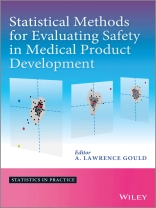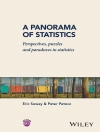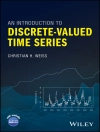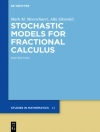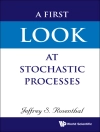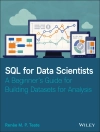This book gives professionals in clinical research valuable information on the challenging issues of the design, execution, and management of clinical trials, and how to resolve these issues effectively. It also provides understanding and practical guidance on the application of contemporary statistical methods to contemporary issues in safety evaluation during medical product development. Each chapter provides sufficient detail to the reader to undertake the design and analysis of experiments at various stages of product development, including comprehensive references to the relevant literature.
* Provides a guide to statistical methods and application in medical product development
* Assists readers in undertaking design and analysis of experiments at various stages of product development
* Features case studies throughout the book, as well as, SAS and R code
Spis treści
Preface xiii
List of Contributors xv
1 Introduction 1
A. Lawrence Gould
1.1 Introduction 1
1.2 Background and context 2
1.3 A fundamental principle for understanding safety evaluation 3
1.4 Stages of safety evaluation in drug development 4
1.5 National medical product safety monitoring strategy 5
1.6 Adverse events vs adverse drug reactions, and an overall view of safety evaluation 5
1.7 A brief historical perspective on safety evaluation 7
1.8 International conference on harmonization 8
1.9 ICH guidelines 9
References 11
2 Safety graphics 22
A. Lawrence Gould
2.1 Introduction 22
2.1.1 Example and general objectives 22
2.1.2 What is the graphic trying to say? 25
2.2 Principles and guidance for constructing effective graphics 26
2.2.1 General principles 26
2.3 Graphical displays for addressing specific issues 26
2.3.1 Frequency of adverse event reports or occurrences 26
2.3.2 Timing of adverse event reports or occurrences 33
2.3.3 Temporal variation of vital sign and laboratory measurements 36
2.3.4 Temporal variation of combinations of vital sign and laboratory measurements 39
2.3.5 Functional/multidimensional data 44
2.3.6 Multivariate outlier detection with multiplicity adjustment based on robust estimates of mean and covariance matrix 48
2.3.7 Monitoring individual patient trends 53
2.4 Discussion 53
References 60
3 QSAR modeling: prediction of biological activity from chemical structure 66
Andy Liaw and Vladimir Svetnik
3.1 Introduction 66
3.2 Data 67
3.2.1 Chemical descriptors 67
3.2.2 Activity data 68
3.3 Model building 69
3.3.1 Random forests 69
3.3.2 Stochastic gradient boosting 70
3.4 Model validation and interpretation 71
3.5 Data example 74
3.6 Discussion 76
References 81
4 Ethical and practical issues in phase 1 trials in healthy volunteers 84
Stephen Senn
4.1 Introduction 84
4.2 Ethical basics 85
4.3 Inferential matters 86
4.3.1 Analysis of serious side-effects 87
4.3.2 Timing of events 87
4.4 Design for subject safety 88
4.4.1 Dosing interval 88
4.4.2 Contemporary dosing 88
4.5 Analysis 89
4.5.1 Objectives of first-in-man trials 89
4.5.2 (In)adequacy of statistical analysis plans 89
4.5.3 'Formal’ statistical analyses 90
4.6 Design for analysis 90
4.6.1 Treatment assignments and the role of placebo 90
4.6.2 Dose-escalation trial design issues 91
4.6.3 Precision at interim stages 93
4.7 Some final thoughts 94
4.7.1 Sharing information 94
4.8 Conclusions 96
4.9 Further reading 96
References 97
5 Phase 1 trials 99
A. Lawrence Gould
5.1 Introduction 99
5.2 Dose determined by toxicity 101
5.2.1 Algorithmic (rule-based) approaches 101
5.3 Model-based approaches 104
5.3.1 Basic CRM design 104
5.3.2 Adaptive refinement of dosage list 105
5.3.3 Hybrid designs 106
5.3.4 Comparisons with rule-based designs 107
5.4 Model-based designs with more than one treatment (or non-monotonic toxicity) 108
5.5 Designs considering toxicity and efficacy 110
5.5.1 Binary efficacy and toxicity considered jointly 110
5.5.2 Use of surrogate efficacy outcomes 112
5.5.3 Reduction of efficacy and toxicity outcomes to ordered categories 112
5.5.4 Binary toxicity and continuous efficacy 113
5.5.5 Time to occurrence of binary toxicity and efficacy endpoints 114
5.5.6 Determining dosage and treatment schedule 115
5.6 Combinations of active agents 117
5.7 Software 117
5.8 Discussion 117
References 118
6 Summarizing adverse event risk 122
A. Lawrence Gould
6.1 Introduction 122
6.2 Summarization of key features of adverse event occurrence 123
6.3 Confidence/credible intervals for risk differences and ratios 126
6.3.1 Metrics 126
6.3.2 Coverage and interpretation 126
6.3.3 Binomial model 127
6.3.4 Poisson model 140
6.3.5 Computational results 142
6.4 Screening for adverse events 142
6.4.1 Outline of approach 146
6.4.2 Distributional model 146
6.4.3 Specification of priors 148
6.4.4 Example 149
6.5 Discussion 151
References 177
7 Statistical analysis of recurrent adverse events 180
Liqun Diao, Richard J. Cook and Ker-Ai Lee
7.1 Introduction 180
7.2 Recurrent adverse event analysis 181
7.2.1 Statistical methods for a single sample 181
7.2.2 Recurrent event analysis and death 183
7.2.3 Summary statistics for recurrent adverse events 184
7.3 Comparisons of adverse event rates 185
7.4 Remarks on computing and an application 186
7.4.1 Computing and software 186
7.4.2 Illustration: Analyses of bleeding in a transfusion trial 188
7.5 Discussion 190
References 191
8 Cardiovascular toxicity, especially QT/QTc prolongation 193
Arne Ring and Robert Schall
8.1 Introduction 193
8.1.1 The QT interval as a biomarker of cardiovascular risk 193
8.1.2 Association of the QT interval with the heart rate 194
8.2 Implementation in preclinical and clinical drug development 194
8.2.1 Evaluations from sponsor perspective 194
8.2.2 Regulatory considerations on TQT trials 196
8.3 Design considerations for 'Thorough QT trials’ 198
8.3.1 Selection of therapeutic and supra-therapeutic exposure 198
8.3.2 Single-versus multiple-dose studies; co-administration of interacting drugs 199
8.3.3 Baseline measurements 199
8.3.4 Parallel versus cross-over design 200
8.3.5 Timing of ECG measurements 200
8.3.6 Sample size 200
8.3.7 Complex situations 200
8.3.8 TQT trials in patients 201
8.4 Statistical analysis: thorough QT/QTc study 201
8.4.1 Data 201
8.4.2 Heart rate correction 203
8.4.3 A general framework for the assessment of QT prolongation 208
8.4.4 Statistical inference: Proof of 'Lack of QT prolongation’ 211
8.4.5 Mixed models for data from TQT studies 212
8.5 Examples of ECG trial designs and analyses from the literature 215
8.5.1 Parallel trial: Nalmefene 215
8.5.2 Cross-over trial: Linagliptin 216
8.5.3 Cross-over with minor QTc effect: Sitagliptin 217
8.5.4 TQT study with heart rate changes but without QTc effect: Darifenacin 218
8.5.5 Trial with both changes in HR and QT(c): Tolterodine 218
8.5.6 Boosting the exposure with pharmacokinetic interactions: Domperidone 219
8.5.7 Double placebo TQT cross-over design 220
8.6 Other issues in cardiovascular safety 220
8.6.1 Rosiglitazone 221
8.6.2 Requirements of the FDA guidance 221
8.6.3 Impact on the development of antidiabetic drugs 223
8.6.4 General impact on biomarker validation 224
References 224
9 Hepatotoxicity 229
Donald C. Trost
9.1 Introduction 229
9.2 Liver biology and chemistry 230
9.2.1 Liver function 230
9.2.2 Liver pathology 232
9.2.3 Clinical laboratory tests for liver status 235
9.2.4 Other clinical manifestations of liver abnormalities 240
9.3 Drug-induced liver injury 240
9.3.1 Literature review 240
9.3.2 Liver toxicology 241
9.3.3 Clinical trial design 243
9.4 Classical statistical approaches to the detection of hepatic toxicity 245
9.4.1 Statistical distributions of analytes 245
9.4.2 Reference limits 245
9.4.3 Hy’s rule and other empirical methods 252
9.5 Stochastic process models for liver homeostasis 253
9.5.1 The Ornstein-Uhlenbeck process model 253
9.5.2 OU data analysis 258
9.5.3 OU model applied to reference limits 263
9.6 Summary 265
References 266
10 Neurotoxicity 271
A. Lawrence Gould
10.1 Introduction 271
10.2 Multivariate longitudinal observations 272
10.3 Electroencephalograms (EEGs) 275
10.3.1 Special considerations 275
10.3.2 Mixed effect models 279
10.3.3 Spatial smoothing by incorporating spatial relationships of channels 281
10.3.4 Explicit adjustment for muscle-induced (non-EEG) artifacts 282
10.3.5 Potential extensions 285
10.4 Discussion 285
References 289
11 Safety monitoring 293
Jay Herson
11.1 Introduction 293
11.2 Planning for safety monitoring 294
11.3 Safety monitoring-sponsor view (masked, treatment groups pooled) 297
11.3.1 Frequentist methods for masked or pooled analysis 297
11.3.2 Likelihood methods for masked or pooled analysis 298
11.3.3 Bayesian methods for masked or pooled analysis 299
11.4 Safety monitoring-DMC view (partially or completely unmasked) 301
11.4.1 DMC data review operations 301
11.4.2 Types of safety data routinely reviewed 301
11.4.3 Assay sensitivity 302
11.4.4 Comparing safety between treatments 304
11.5 Future challenges in safety monitoring 312
11.5.1 Adaptive designs 312
11.5.2 Changes in the setting of clinical trials 313
11.5.3 New technologies 313
11.6 Conclusions 313
References 314
12 Sequential testing for safety evaluation 319
Jie Chen
12.1 Introduction 319
12.2 Sequential probability ratio test (SPRT) 320
12.2.1 Wald SPRT basics 320
12.2.2 SPRT for a single-parameter exponential family 321
12.2.3 A clinical trial example 322
12.2.4 Application to monitoring occurrence of adverse events 323
12.3 Sequential generalized likelihood ratio tests 325
12.3.1 Sequential GLR tests and stopping boundaries 325
12.3.2 Extension of sequential GLR tests to multiparameter exponential families 327
12.3.3 Implementation of sequential GLR tests 327
12.3.4 Example from Section 12.2.3, continued 328
12.4 Concluding remarks 330
References 331
13 Evaluation of post-marketing safety using spontaneous reporting databases 332
Ismaïl Ahmed, Bernard Bégaud and Pascale Tubert-Bitter
13.1 Introduction 332
13.2 Data structure 333
13.3 Disproportionality methods 334
13.3.1 Frequentist methods 334
13.3.2 Bayesian methods 335
13.4 Issues and biases 337
13.4.1 Notoriety bias 337
13.4.2 Dilution bias 338
13.4.3 Competition bias 338
13.5 Method comparisons 339
13.6 Further refinements 339
13.6.1 Recent improvements on the detection rule 339
13.6.2 Bayesian screening approach 340
13.6.3 Confounding and interactions 341
13.6.4 Comparison of two signals 341
13.6.5 An alternative approach 341
References 342
14 Pharmacovigilance using observational/longitudinal databases and web-based information 345
A. Lawrence Gould
14.1 Introduction 345
14.2 Methods based on observational databases 347
14.2.1 Disproportionality analysis with redefinition of report frequency table entries 347
14.2.2 LGPS and LEOPARD 350
14.2.3 Self-controlled case series (SCCS) 350
14.2.4 Case-control approach 351
14.2.5 Self-controlled cohort 352
14.2.6 Temporal pattern discovery 353
14.2.7 Unexpected temporal association rules 354
14.2.8 Time to onset for vaccine safety 355
14.3 Web-based pharmacovigilance (infodemiology and infoveillance) 356
14.4 Discussion 357
References 358
Index 361
O autorze
A. Lawrence Gould, Senior Director, Scientific Staff, Merck Research Laboratories, USA.
